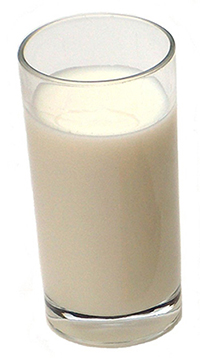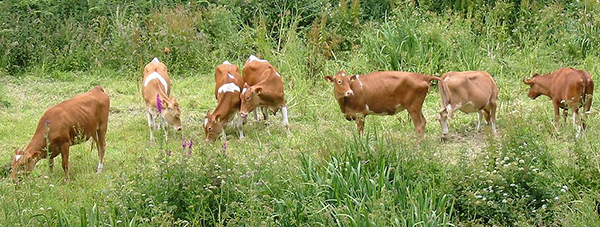When I first encountered that word, insulinogenic, I completely garbled its pronunciation. In-su-lino-whadya-hooya? What the Hades?
In-su-lino-gen-ic. Right.
So what does it mean? It means something that stimulates the production of insulin. In the context of milk, it means that milk produces a much bigger insulin response in the human body than it has any right to, given the amount of carbohydrates present in milk, mostly in the form of the milk sugar lactose. Milk punches so high above its carb content that it produces an insulin response like that of white bread!
Why is this of concern to me?
Well…when I was diagnosed with osteoporosis, I really stepped up my milk intake. I didn’t know that milk was insulinogenic, and I did know that my bones could use all the help they could get.
 I found it difficult to drink 4 cups a day, so I began adding a pinch of stevia along with cocoa powder to my evening milk. Yum! It tasted like dessert!
I found it difficult to drink 4 cups a day, so I began adding a pinch of stevia along with cocoa powder to my evening milk. Yum! It tasted like dessert!
Meanwhile, my weight had been creeping up. There seemed to be several obvious reasons for that. I had two health problems in sequence that kept me away from the gym for nearly 2 years. I’d allowed pasta back into my menu, perhaps once every 10 days. And I was getting into my middle fifties. I didn’t like the upward creep, naturally.
I was relieved when I resolved my health problems enough to return to the gym in May 2016. And I rededicated myself to kicking the pasta back out of my menu. Remembering when I tried Phil Maffetone’s 2-week test with such stellar results, I expected to see the start of a drop in weight. Imagine my surprise when I continued to gain!
“How can this be?” I asked myself. “I’m swimming three times a week. Lifting weights two or three times a week. I’m eating fewer than 50 grams of carbs per day. My calorie intake is modest; I’ve never been a big overeater. What the Hades gives?”
This unfortunate upward trend continued. “I wonder if it is the milk?” I asked myself.
You would think I might have done some more reading about milk, but I didn’t. I was attached to my milk. Besides, it was healthy milk from grass-fed cows lovingly tended by my local farmer, who had managed the apprentices at the famous Polyface Farm. It couldn’t be the milk!
I tried to cut down and found that I couldn’t. Oh, oh! Was I addicted to milk?
Finally, in November 2016, after months of “quitting milk” and then “I’ll just have one last big glass tonight,” I decided I needed support. I’d visited a website devoted to the Whole30 way of eating some while back and noted that the Whole30 was the way I wanted to eat and that the site had forums. A forum sounded like exactly what I needed.
And it was!
Hanging out with a bunch of others who were eating the same way I wanted to eat – and posting on my progress – enabled me to give up the milk and ditch the last remnants of pasta. I saw almost immediate results. I had an annual exam scheduled with my doctor 3 weeks after I started my Whole30, and I found I’d lost 7 pounds. Without counting calories. Just by waving goodbye to milk. (Since I doubt my previous once or twice a month indulgence in pasta was the key to my previous weight gain.)
I also found my energy levels increasing and my mood improving. I felt good!
After 30 days of no milk (and no grains, no legumes, and no sugar – none), I’d lost 9 pounds. I decided to carry on as I was. I liked how I felt, I liked all the new meals I’d learned how to cook, I liked everything about my new routine. So far, I’m still losing weight, 20 pounds and counting at about one-and-a-half pounds per week. My yoga pants are beginning to get too loose!
It was only after these stellar results that I did a little researching on milk and learned that it is highly insulinogenic. Even my healthy milk from a local dairy farm run by a super careful and informed grass farmer.
When I was younger, I could get away with eating insulinogenic foods. At least, they didn’t pack the pounds on me, although – looking back – they did have other more subtle negative effects. But as I’ve gotten older, insulin in my bloodstream started to have the effect that it does in many, acting as a one-way gatekeeper that packs fat into the fat cells and doesn’t allow any withdrawals of that fat for energy. No more milk for this lady!
But what will I do for my osteoporosis?
That’s another blog post. Which I will write. I also plan to share more about my adventures with the Whole30 in future posts. But this is enough for now. 😀
For more about the effects of insulin, see:
Test first, then conclude!
For more on nutrition, see:
Why Seed Oils Are Dangerous
Thinner and Healthier
Butter and Cream and Coconut, Oh My!
Can’t wait for my future posts to learn more about the Whole30? See:
Whole30.com


I’m glad you’re starting to discuss Whole30. I’ve been curious since you first mentioned it.
But I’m feeling pretty damn tragical about the milk news! I’ve been having 3 glasses a day and am not shaking the weight. Of course, a fitbit is telling me I’ve not gotten near the normal movement in that I should be, so I know that’s some of it, too. I go to the weight room twice a week, and have one yoga and one martial arts class, but now that I’m working at home, I’ve lost all that walking between places I used to get. I’ve been drinking it for my bones, too, and look forward to learning what your research has told you about that.
I felt uber sad when I first started suspecting that milk was making me gain weight. But I’m mostly over it – especially because I will probably be able to have heavy cream (in moderate quantities) instead. I want to follow the Whole30 protocol for testing cream, before I start consuming it, however, and I haven’t yet been at the right place to do that testing. For one thing, I’m too delighted about my steady march to a lower weight. I don’t want to do anything to jinx that!
I plan to write several blog posts about my experience with the Whole30. And – of course – I’ll also be sharing my findings about osteoporosis and how to rebuild bone strength. (Key: It’s not just about bone density. It’s also about bone strength. Some of the popular drugs prescribed for osteoporosis will improve the density as measured by bone scans, but do not actually deliver better results – fewer broken bones – when you fall.)
I am really, really, looking forward to the osteo posts.
After reading this post, I reduced my dairy to twice a day. I confess it had gotten to recreational levels of consumption. Just the reduction has helped.
I checked out the Whole30 website, and it said no oatmeal. I’m thinking that might be harder to abandon than the milk. I’m going to see how this less-milk thing goes and be more diligent about processed carbs and sugar.
Your plan sounds good.
One thing to keep in mind about the Whole30 is that it is intended to be used as a personal diagnostic tool. You follow it for 30 days and then do controlled re-introductions so that you know exactly how certain categories of foods affect your own body. Everyone is different. For example, one person in the thread I’m visiting on the Whole30 forum discovered that eggs upset her stomach whenever she eats them, whereas eggs are a staple food for me.
Does this mean my EAS protein shakes, which are whey protein, are my problem?
I don’t drink milk – haven’t for years – but this is my breakfast protein most days, and often a late afternoon snack (150 calories), and sometimes the thing I drink late at night so I sleep through.
Hadn’t even thought they might be the reason the weight is staying quite stubbornly on.
We can’t win, can we?
Whey is the most insulinogenic part of milk, so I would not be surprised if the shakes were a significant factor in an inability to shed pounds. IMO. It’s always the “fine print” that gets you, and the insulinogenic property of milk seems decidedly fine print to me. ::wry grin::
A little reading – and the whey is not looking good; the logical part being that it is a food for babies to grow quickly on.
Oops. I will try plain chicken for a while, skip the wonderful chocolate (protein) shakes I’ve been making for breakfast.
I don’t care much what I eat any more – nothing tastes right, anyway. If I can supply straight protein without kicking off the insulin reaction, my body loses fat – converted to energy.
I thought I’d found the perfect mixture – half chicken, half protein shakes. Oops.
Thanks!
Exactly! Alas! I did like my own milk concoctions, but I am not content to grow ever weightier when there is something I can do about it. Your new plan sounds good. Best of luck with it!